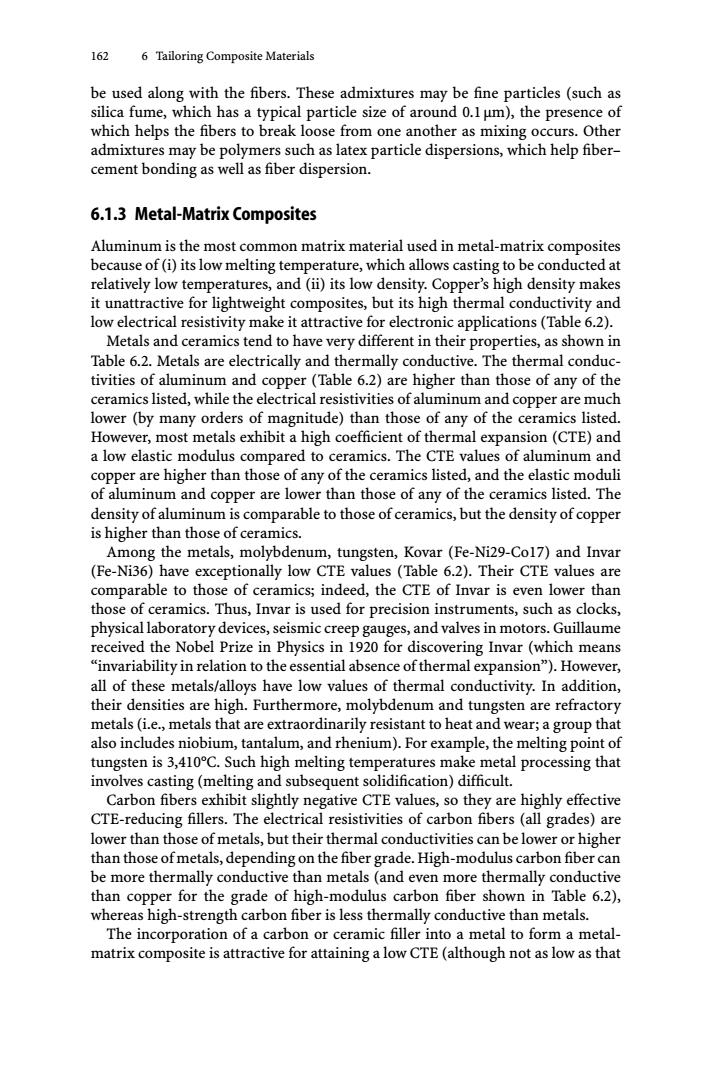正在加载图片...

162 6 Tailoring Composite Materials be used along with the fibers.These admixtures may be fine particles (such as silica fume,which has a typical particle size of around 0.1 um),the presence of which helps the fibers to break loose from one another as mixing occurs.Other admixtures may be polymers such as latex particle dispersions,which help fiber- cement bonding as well as fiber dispersion. 6.1.3 Metal-Matrix Composites Aluminum is the most common matrix material used in metal-matrix composites because of(i)its low melting temperature,which allows casting to be conducted at relatively low temperatures,and(ii)its low density.Copper's high density makes it unattractive for lightweight composites,but its high thermal conductivity and low electrical resistivity make it attractive for electronic applications(Table 6.2). Metals and ceramics tend to have very different in their properties,as shown in Table 6.2.Metals are electrically and thermally conductive.The thermal conduc- tivities of aluminum and copper(Table 6.2)are higher than those of any of the ceramics listed,while the electrical resistivities of aluminum and copper are much lower (by many orders of magnitude)than those of any of the ceramics listed. However,most metals exhibit a high coefficient of thermal expansion(CTE)and a low elastic modulus compared to ceramics.The CTE values of aluminum and copper are higher than those of any of the ceramics listed,and the elastic moduli of aluminum and copper are lower than those of any of the ceramics listed.The density of aluminum is comparable to those of ceramics,but the density of copper is higher than those of ceramics. Among the metals,molybdenum,tungsten,Kovar(Fe-Ni29-Col7)and Invar (Fe-Ni36)have exceptionally low CTE values (Table 6.2).Their CTE values are comparable to those of ceramics;indeed,the CTE of Invar is even lower than those of ceramics.Thus,Invar is used for precision instruments,such as clocks, physical laboratory devices,seismic creep gauges,and valves in motors.Guillaume received the Nobel Prize in Physics in 1920 for discovering Invar(which means "invariability in relation to the essential absence of thermal expansion").However, all of these metals/alloys have low values of thermal conductivity.In addition, their densities are high.Furthermore,molybdenum and tungsten are refractory metals(i.e.,metals that are extraordinarily resistant to heat and wear;a group that also includes niobium,tantalum,and rhenium).For example,the melting point of tungsten is 3,410C.Such high melting temperatures make metal processing that involves casting(melting and subsequent solidification)difficult. Carbon fibers exhibit slightly negative CTE values,so they are highly effective CTE-reducing fillers.The electrical resistivities of carbon fibers (all grades)are lower than those of metals,but their thermal conductivities can be lower or higher than those of metals,depending on the fiber grade.High-modulus carbon fiber can be more thermally conductive than metals(and even more thermally conductive than copper for the grade of high-modulus carbon fiber shown in Table 6.2), whereas high-strength carbon fiber is less thermally conductive than metals. The incorporation of a carbon or ceramic filler into a metal to form a metal- matrix composite is attractive for attaining a low CTE(although not as low as that162 6 Tailoring Composite Materials be used along with the fibers. These admixtures may be fine particles (such as silica fume, which has a typical particle size of around 0.1μm), the presence of which helps the fibers to break loose from one another as mixing occurs. Other admixtures may be polymers such as latex particle dispersions, which help fiber– cement bonding as well as fiber dispersion. 6.1.3 Metal-Matrix Composites Aluminum is the most common matrix material used in metal-matrix composites because of (i) its low melting temperature, which allows casting to be conducted at relatively low temperatures, and (ii) its low density. Copper’s high density makes it unattractive for lightweight composites, but its high thermal conductivity and low electrical resistivity make it attractive for electronic applications (Table 6.2). Metals and ceramics tend to have very different in their properties, as shown in Table 6.2. Metals are electrically and thermally conductive. The thermal conductivities of aluminum and copper (Table 6.2) are higher than those of any of the ceramics listed, while the electrical resistivities of aluminum and copper are much lower (by many orders of magnitude) than those of any of the ceramics listed. However, most metals exhibit a high coefficient of thermal expansion (CTE) and a low elastic modulus compared to ceramics. The CTE values of aluminum and copper are higher than those of any of the ceramics listed, and the elastic moduli of aluminum and copper are lower than those of any of the ceramics listed. The density of aluminum is comparable to those of ceramics, but the density of copper is higher than those of ceramics. Among the metals, molybdenum, tungsten, Kovar (Fe-Ni29-Co17) and Invar (Fe-Ni36) have exceptionally low CTE values (Table 6.2). Their CTE values are comparable to those of ceramics; indeed, the CTE of Invar is even lower than those of ceramics. Thus, Invar is used for precision instruments, such as clocks, physical laboratory devices, seismic creep gauges, and valves in motors. Guillaume received the Nobel Prize in Physics in 1920 for discovering Invar (which means “invariability in relation to the essential absence of thermal expansion”). However, all of these metals/alloys have low values of thermal conductivity. In addition, their densities are high. Furthermore, molybdenum and tungsten are refractory metals (i.e., metals that are extraordinarily resistant to heat and wear; a group that also includes niobium, tantalum, and rhenium). For example, the melting point of tungsten is 3,410°C. Such high melting temperatures make metal processing that involves casting (melting and subsequent solidification) difficult. Carbon fibers exhibit slightly negative CTE values, so they are highly effective CTE-reducing fillers. The electrical resistivities of carbon fibers (all grades) are lower than those of metals, but their thermal conductivities can be lower or higher than those of metals, depending on the fiber grade. High-modulus carbon fiber can be more thermally conductive than metals (and even more thermally conductive than copper for the grade of high-modulus carbon fiber shown in Table 6.2), whereas high-strength carbon fiber is less thermally conductive than metals. The incorporation of a carbon or ceramic filler into a metal to form a metalmatrix composite is attractive for attaining a low CTE (although not as low as that